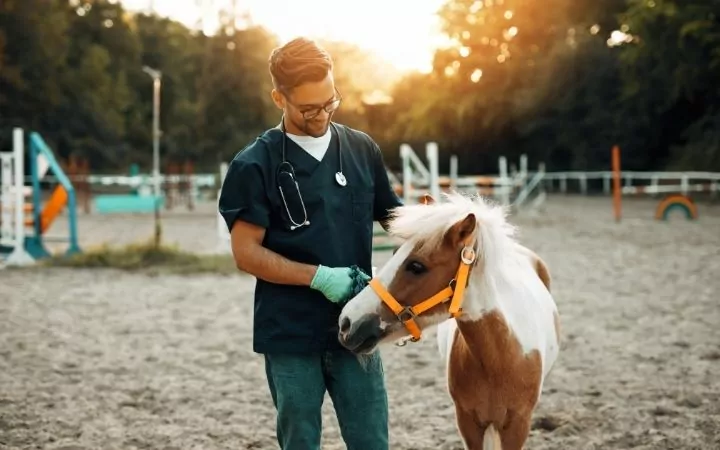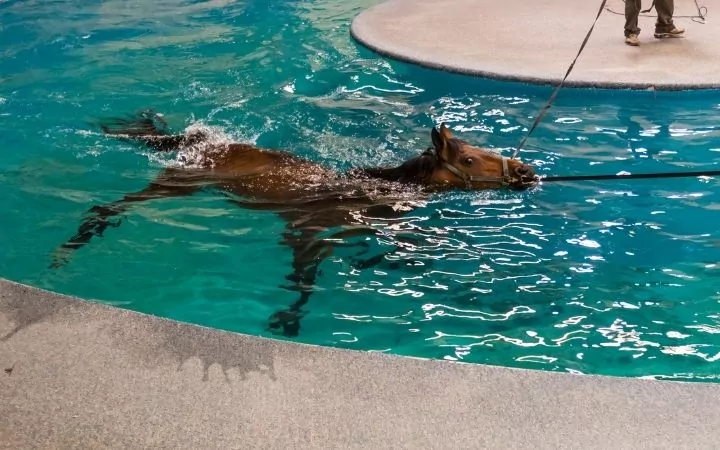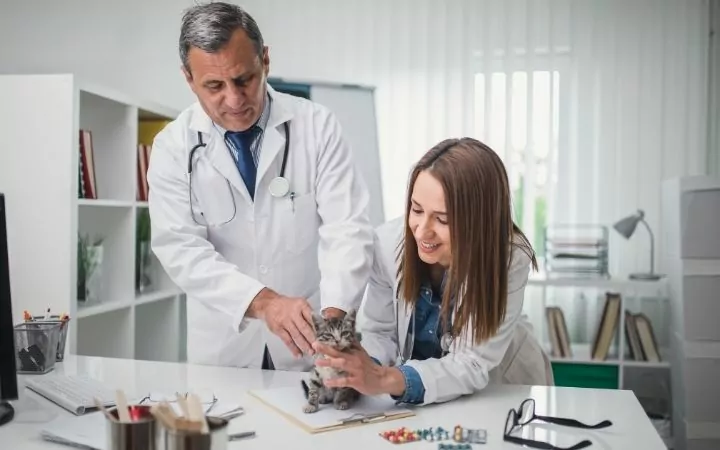The Start of Animal Physical Therapy
The veterinary fraternity has acknowledged the benefits of animal physical therapy. However, the clinical application and relevance are still in their early stages. Sir Charles Strong is believed to be one of the pioneers of animal rehabilitation. Sir Charles published a book on Equine Physiotherapy in the 1960s. He titled the book “Horses’ Injuries, Common-Sense Therapy of Muscles and Joints for the Layman.”
As equine sports became more prevalent, associated racehorse injuries also increased. As a result, horses are among the first four-legged animals to benefit from physical therapy.
In the 1980s, canine rehabilitation was widespread in Europe, and later in the 1990s, it spread to the U.S.
The American Medical Association added “animal physical therapy” to its guidelines in 1996, paving the way for the first animal rehabilitation certificate program. If you would like to learn more about this profession, read our full article on how to become an equine vet.

Not only will you gain valuable insight into the educational programs, but you can read about the different equine specialties you can pursue, like working with racehorses.
Veterinary medicine is following in the footsteps of human medicine. The discipline has shifted focus to become more preventive as opposed to being curative and palliative.
The rise in popularity of canine rehabilitation has encouraged the increase in the number of animal physical therapy colleges. Dr. Janet Van Dyke established the Canine Rehabilitation Institute in 2003. The institute admitted students aspiring to become professionals equipped with tools and knowledge to treat our animals.
The University of Tennessee came up with a slew of higher education to prepare professionals for animal rehabilitation. They train:
- Veterinarians and vet technicians/technologists.
- Physical therapists (PTs).
- Physical therapy assistants (PTAs).
- Occupational therapists (OTs).
- Occupational therapy assistants (OTAs).
How to Become an Animal Physical Therapist
If you aspire to be an animal therapist, two institutions offer animal physical therapy certification. You can go to the University of Tennessee (UoT) or join The Canine Rehabilitation Institute (CRI).
At the CRI, you will train to get the Canine Rehabilitation Therapist Certification. However, prospective students must have a physical therapy license to be eligible for enrollment. The UoT offers the Canine Rehabilitation Certificate Program (CCRP) to PTs, PTAs, and students of these disciplines.

You will also find the following animal physical therapy programs at UoT:
- Canine osteoarthritis case management.
- Equine rehabilitation.
- Canine pain management.
- Equine taping.
- Canine fitness training.
- Nutrition case management.
It will help if you visit the CRI and UoT official websites to get a more comprehensive description of the programs.
The Benefits of Pursuing This Career
When you choose to pursue a career in animal physical therapy, you will gain numerous benefits. The most notable advantages of animal rehabilitation jobs include:
- There are several career paths you can follow to become a physical therapist.
- The field is new, and the demand for animal therapists is high. Therefore, once you graduate, you will get a job quickly. Furthermore, the Bureau of Labor Statistics (BLS) reports that the animal therapist job market is set to grow steadily for the next couple of years.
- The rehabilitation nursing salary is competitive. Animal therapists take home a considerable wage annually.
- If you love animals, you will get job satisfaction when you see the injured or ill animals recover based on your rehabilitation plan.

The Responsibilities of an Animal PT
When you qualify to become an animal physical therapist, these are the responsibilities you will have:
- Observing animal patients and performing exams.
- Determining an appropriate animal rehab or recovery plan.
- Communicating with clients and veterinarians to agree on a rehabilitation plan and settle on medical treatment.
- Use laser therapy, radiography, ultrasound, and shockwave equipment.
- Helping animal patients in strengthening and exercise schedules.
- Stretching and massaging animal patients.
- Plan for checkups with clients after completion of the rehabilitation plan.
Your responsibilities might vary from place to place based on the cases you handle. But the duties mentioned above are the most common.
The Required Education and Training
Professionals from different fields can practice animal physical therapy. This means that there are multiple career paths you can follow to become an animal physical therapist. Here are the requirements for becoming a physical therapist:
If you are an undergraduate student aspiring to become a physical therapist, you must take mathematics and science courses. You must also get volunteer experience in an animal hospital or rehabilitation center. This will make you more competitive for physical therapy programs.
Students must obtain at least a master’s degree to become animal therapists. You will also find animal physical therapy schools offering doctoral programs. You will have to study for up to 30 months to get your master’s degree.
Some courses physical therapy students study include:
- Pharmacology.
- Pathology.
- Anatomy.
- Musculoskeletal imaging.
- Neuroscience.
- Comparative Physiology.
- Animal Behavior.
- Biomechanics.
- Animal handling.
- Infectious diseases.

The other things they must learn include:
- Diagnostic processes.
- Therapeutic interventions.
- Medical screening.
- Pain detection.
- Identifying red flags for a pet.
Above all, students must ensure they get practical clinical experience by going for an externship at an animal rehabilitation center. Once you graduate, you must be licensed. Graduates must sit for and pass the National Physical Therapy Examination. Some states usually have state-specific requirements for licensure.
You might have to sit for jurisprudence exams and get continuing education and training to maintain your license. Now that you know the physical therapist education needed, read on to find out the ailments you will be dealing with.
Some of the Common Ailments That can be Treated with PT
Physical therapists work with animals to treat them. There are numerous reasons an animal would need rehabilitation. However, the most prevalent diagnoses animal physical therapists treat are:
- Hip dysplasia.
- Arthritis.
- Post-operative care.
- Tendonitis.
- Degenerative joint disease (DJD) or degenerative disc disease (DDD).
- Vestibular and balance disorders.
- Nerve injuries.

A General Job Description
As you apply for animal physical therapy jobs, you will come across the general job description. As a PT, this is what your job entails:
- Providing rehabilitative care to animals that have undergone surgery, have injuries, or suffer chronic pain to speed up recovery and boost life quality.
- Apply the following treatments to animals:
- Exercise rehabilitation.
- Massage.
- Aquatic therapy.
- Neuromuscular stimulation.
- Heat therapy.
- Cold therapy.
- Ultrasound therapy.
- Cryotherapy.
- Passive range of motion activity.
Your physical therapist duties aim to speed up the recovery process by:
- Increasing blood flow to the injured area.
- Minimizing muscle atrophy.
- Reducing inflammation.
- Normalizing joint function.
- Boosting collagen synthesis.
Job Outlook and Salary Prospects
According to the U.S. Bureau of Labor Statistics, animal physical therapists’ jobs will grow faster than the average rate between now and 2008. The BLS also reported that the salary for animal physical therapists on average is 123,350 USD per year. Veterinary medicine attracts the highest wages at 162,450 USD per year.
The numbers show that pursuing a career in animal physical therapy would be worthwhile. If you love animals, you will love working with animals in any of the animal therapist jobs.
Furthermore, an animal physical therapy salary is high enough to cater to your needs.
Generally, as an animal physical therapist, your work is to do physical therapy on animals. Training for this career may last at least two years after high school. However, licensing requirements will vary based on state-specific guidelines.
As a physical therapist, your goal is to offer care that will improve animals’ quality of life. The animals you will deal with are either injured, suffer chronic pain, or are ill. The most common animals you will treat are pet dogs and horses.
Bear in mind that some of the links in this article are affiliate links and if you go through them to make a purchase we will earn a commission. We promote dogmedlaser.com and their products because of their quality and not because of the commission. The decision is yours, and whether or not you decide to buy something is completely up to you.

